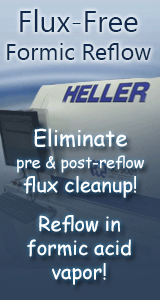First responding to your questions: * Is it possible to add the via holes to the stencil and print paste into them and expect them to plug? => Yes, providing the surface of the via is solderable. * If so, how much paste? => Vias come in various sizes. Boards vary in thickness. So, the amount of paste to fill a via varies. Roughly, you�ll need twice as much paste as the volume of the via that you want fill. [So generally, overprinting the via pad is a drop in the bucket.] Search the fine SMT Archives for postings on: pin and paste � paste and hole � etc. for help in determining aperture size, issues, and what not.
Next, many companies like closed vias to improve the gasketing of their automated test equipment. And filling the vias with paste works fine at accomplishing that task. Additional points are: * In the distant past, Roger Wild at IBM showed that an unfilled via was most reliable, a completely filled via was almost as reliable as an unfilled via, and a partially filled via was not at all reliable. Wild, in his study, subjected bare boards to several (thousands I think) of fairly stringent thermal cycles and monitored PWB both for an increase in resistance and an open circuit. * Solder, printed into vias during first pass, can flow out of vias and cause gasketing problems, when printing second pass paste. * Fabricators use a variety of techniques for via plugging, as an alternative to solder filled vias. * In fact, fabricators go out of their way to remove the solder from vias on HASL boards. * Obviously, vias that are specified small are easier to fill with solder than wide vias. While the logical extension, plating vias closed is unwise, because plating closes at the top and bottom first. This could trap plating chemicals in the via. * Stenciling or dispensing adhesive on the side of the via opposite to the probe point is another alternative to solder filling of vias.
reply »
![]() We have a customer that desires to have their via holes plug...
- Mar 04, 2002
by
We have a customer that desires to have their via holes plug...
- Mar 04, 2002
by
![]()
![]()
![]() First responding to your questions:
* Is it possible to add...
- Mar 04, 2002
by
davef
First responding to your questions:
* Is it possible to add...
- Mar 04, 2002
by
davef
![]()
![]()
![]() You better be careful how you plug vias at screenprint - we ...
- Mar 05, 2002
by
You better be careful how you plug vias at screenprint - we ...
- Mar 05, 2002
by
![]()









